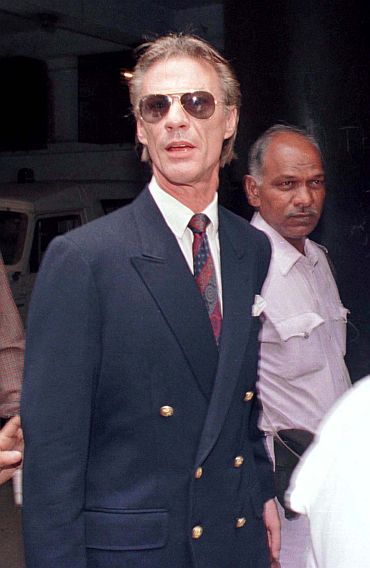 | « Back to article | Print this article |
Purulia arms drop, an embarrassment to Indian intel
Though the Indian intelligence agencies were tipped off that the consignment of arms and ammunition would be dropped in Purulia, West Bengal they failed to avert the incident. Both the R&AW and Intelligence Bureau approached it as a routine case making it one of the most shameful episodes in the history of Indian intelligence, writes senior analyst B Raman.
The clandestine Purulia arms drop of December 1995, in which an aircraft piloted by a group of mercenaries hired by an unidentified extremist organidation -- suspected to be the Anand Marg -- managed to fly right across the Indian air space to Purulia in West Bengal, air drop a consignment of arms and ammunition to a collecting party on the ground and fly to Pattaya in Thailand unintercepted by the Indian intelligence and security agencies and the air force. This, despite the availability of precise advance intelligence is a shameful episode in the history of Indian intelligence.
A few weeks before the actual incident, the extremist organisation, which had procured the arms and ammunition, had approached a retired pilot of the British Air Force and offered to pay him handsomely if he organised the air drop successfully. Even though tempted by the sum offered, he did not initially agree to carry out the operation. He asked for time to think over it. He then contacted an official of the British defence ministry and told him about the offer made to him by the extremists. The official advised him not to reject the offer and wait for further instructions.
The defence ministry official then told MI-5, the British security service, about the conspiracy. The MI-5 immediately informed the Research & Analysis Wing with which it had a liaison relationship. The R&AW, after examining the matter, asked MI-5 to advise the pilot to accept the task and to keep the security service informed of all his meetings with the extremist organisation and the detailed plans for the air drop including the date and time, the place of the air drop and the flight path.
Purulia arms drop, an embarrassment to Indian intel
Normally, in such cases, if the matter had been handled professionally, the R&AW would have taken the clearance of the prime minister for flying out a team of officers of the IB and the R&AW to the United Kingdom to meet the pilot secretly with the help of MI-5 and the British defence ministry. It would take his co-operation for organising a trap so that the party could have been arrested while collecting the air dropped arms and ammunition and the identity of the extremist organisation established.
Nothing of that sort was done. The R&AW passed on the information in a routine manner to the IB without specifying that it was coming from the pilot through MI-5. The IB, instead of organising the follow-up action, passed it on to the West Bengal police in an equally routine manner. The then chief secretary of the West Bengal government later complained that the IB had sent the information by registered post and that it was received after the air drop had taken place and the aircraft had flown out of India.
One does not know whether the R&AW and the IB kept the Indian Air Force in the picture so that the IAF could have kept track of the plane and made sure that the pilot did not play any tricks. The plane entered the air space over Mumbai from Pakistan, flew to the air space over Purulia, air dropped the arms and ammunition and then flew to Pattaya in Thailand.
In the meanwhile, most of the air dropped arms and ammunition had been removed by unidentified elements. The IB issued an alert to all concerned to look for the plane if it flew over the Indian air space again while flying back to the UK.
Purulia arms drop, an embarrassment to Indian intel
The Indian Air Force intercepted the aircraft before it could leave the Indian air space and forced it to land at Mumbai. One person on board the plane, who reportedly belonged to the extremist organisation, managed to quietly walk out of the airport without being stopped by the security and the immigration.
The British pilot and crew were arrested. Sections of the media had reported that the pilot was in a very violent mood and abused the police and intelligence officials.
No wonder. He had taken the initiative in alerting the intelligence agencies and keeping them informed of all the details. He expected that he would be honoured and rewarded. Instead, he was allegedly treated roughly, prosecuted and jailed.
A few weeks after this incident, the then British home secretary had come to India on a scheduled visit. In his interaction with our local media, he pointed out how the British intelligence had kept its Indian counterpart informed.
I have been writing about this shameful episode off and on since 1996. In my book Intelligence -- Past, Present and Future published in 2001 I had stated, "The normal response of any professional counter-terrorism agency, on the receipt of such precise information, would have been to organise a trap in co-operation with the pilot who had reportedly volunteered the information, for catching the terrorists on the ground while they were collecting the arms and ammunition after the air drop. Till now, no satisfactory explanation has been forthcoming from the security agencies as to why this was not done."
We do not know the answer to this even today.


